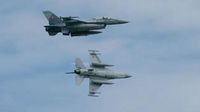On May 8, 2025, Belgium's Minister of National Defense, Theo Francken, made a significant announcement regarding the transfer of F-16 fighter jets to Ukraine. He stated that the country could only deliver these aircraft "in the coming years" after receiving F-35 jets from the United States, a condition that has raised eyebrows in military and diplomatic circles.
Francken's remarks came during an event in Washington on May 6, where he emphasized Belgium's commitment to supporting Ukraine's air force, despite the fact that no F-16s have yet been provided. "Belgium is the largest supporter of Kiev in the air force sector," he asserted, highlighting the country's strategic role in the ongoing conflict.
In 2023, Belgium, along with NATO allies Denmark, the Netherlands, and Norway, pledged to supply Ukraine with up to 80 F-16s. To date, Ukraine has received approximately 20 of these aircraft from Denmark and the Netherlands, but the anticipated delivery from Belgium remains in limbo due to the dependency on the F-35 acquisition.
Francken explained that Brussels plans to transfer 30 operational F-16s to Ukraine once they have received their F-35s from the US. "When we receive the F-35s from the US, we will transfer the F-16s," he said, indicating a clear timeline that is contingent on international military logistics.
Adding to the discussion, Belgian Prime Minister Bart De Wever recently announced that the country would send two decommissioned F-16s to Ukraine by the end of 2025 for use as spare parts. This move, while modest, underscores Belgium's ongoing commitment to assist Ukraine amidst the conflict.
In terms of financial support, De Wever revealed that Belgium would provide military assistance worth 1 billion euros (approximately 1.1 billion USD) annually to Ukraine, a decision expected to be approved by the government in the coming weeks. This substantial commitment highlights Belgium's strategic partnership with Ukraine as it continues to navigate the complexities of the war.
Last week, the United States approved a deal worth 310.5 million USD to maintain the operation of F-16s already in use by Ukraine. This package includes training, spare parts, upgrades, logistical support, and software for the fourth-generation aircraft, ensuring that Ukraine can effectively utilize its current fleet.
Despite these assurances, the situation remains precarious. In April 2025, the Russian Ministry of Defense reported that its air defense system shot down an F-16, marking the second loss of a US-designed fighter jet by Ukraine during the ongoing war. This incident has raised questions about the effectiveness of the F-16s in active combat, as their deployment has primarily been for air defense rather than direct engagement.
Ukrainian officials had previously touted the F-16 as a potential "game changer" in their conflict with Russia, yet the reality on the ground suggests that their operational capacity may be limited. The jets have mostly been utilized away from the front lines, serving primarily for defensive missions.
As the geopolitical landscape evolves, the dynamics of military support among NATO countries and Ukraine will continue to be scrutinized. Francken's statements reflect a broader strategy within NATO to bolster Ukraine's defense capabilities while also navigating the complexities of national military readiness.
The implications of Belgium's delay in transferring F-16s may resonate beyond the immediate conflict. As NATO allies coordinate their support for Ukraine, the reliance on American fighter jets highlights the interconnectedness of military logistics and international diplomacy.
In summary, Belgium's commitment to Ukraine is evident, but the timeline for delivering F-16s remains uncertain. With ongoing military engagements and the need for strategic planning, the situation will require careful monitoring as both nations work to fortify their defenses against external threats.

